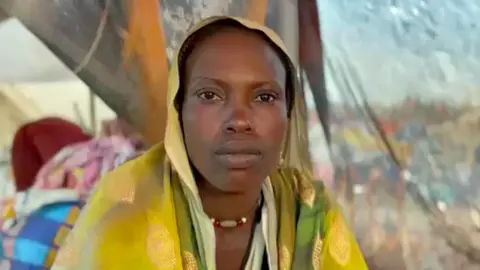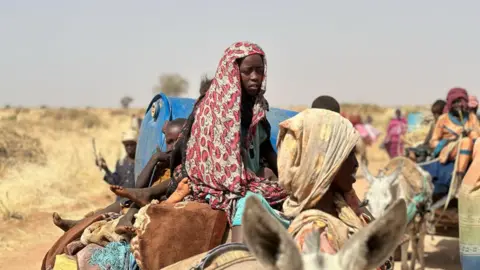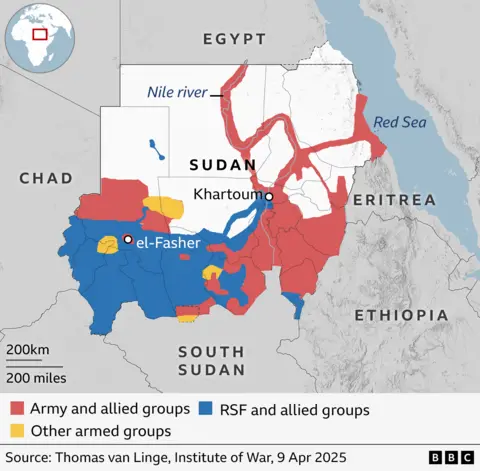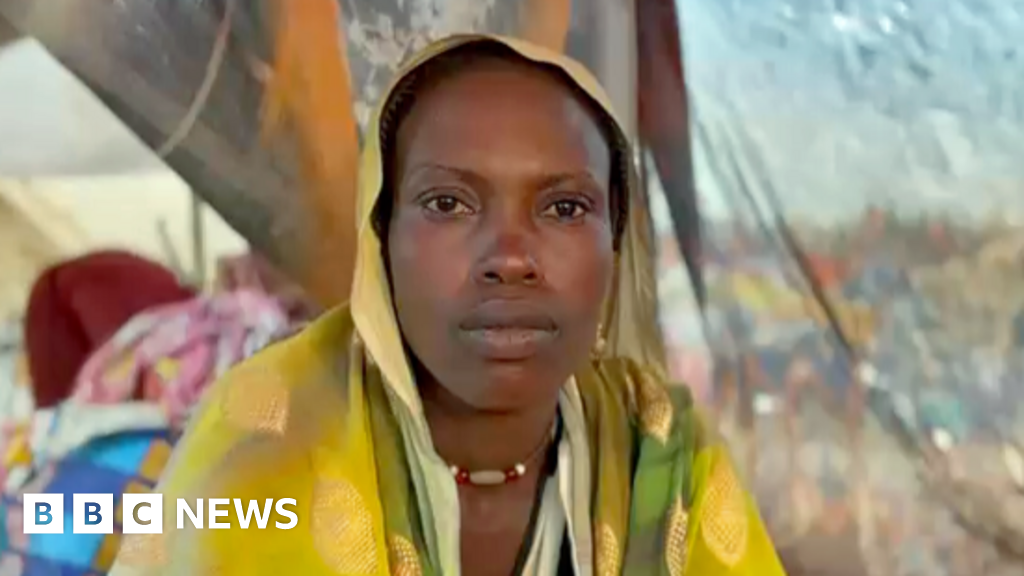 BBC
BBCThe 700,000 residents of Sudan’s Zamzam camp were already among the world’s most destitute people when they were attacked by paramilitary fighters last week.
Two decades of conflict in the Darfur region, which intensified after civil war broke out across the whole of Sudan two years ago, meant they had already fled their homes to find safety and shelter.
They gradually began to rebuild their lives at Zamzam, Sudan’s biggest camp for internally displaced people.
But any sense of stability was upended when the camp was ravaged by an intense ground and aerial assault.
Zamzam was attacked by the paramilitary Rapid Support Forces (RSF), which has been trying to seize the nearby city of el-Fasher from its rivals, the Sudanese army.
The RSF has denied reports of atrocities at Zamzam but confirmed it had taken over the camp.
As a result of the attack, Zamzam is “completely destroyed”, North Darfur Health Minister Ibrahim Khater told the BBC’s Newsday programme.
“No-one is there,” he said.
Among the many thousands who fled Zamzam was 28-year-old Fathiya Mohammed, who had been at the camp for three months.
She walked barefoot for four days before reaching the town of Tawila.
“I was carrying one child on my back, another in my arms, and luggage on my head,” she told the BBC.

She lost her husband during the chaos of the attack and still does not know where he is.
The family were attacked by thieves on the journey to Tawila, Ms Mohammed said, and they endured exhaustion, hunger and thirst.
Medical charity Doctors Without Borders (MSF) says that tens of thousands of people have fled from Zamzam to Tawila since the attack.
Saadiya Adam left the camp with her children aged two and five after her makeshift home was destroyed.
“They burned my house in Zamzam and they burned my sheep,” said Ms Adam, who had been living in Zamzam for two months.
“Everything I owned was burned. I have nothing left.”
Images filmed by a freelance journalist working for the BBC show thousands of internally displaced people entering Tawila by foot, truck and donkey cart.

These arrivals face overwhelmed facilities – MSF said that over two days, more than 20,000 people have sought treatment at the hospital it runs in Tawila.
“We see many people injured by bullets, it is becoming routine,” said head nurse Tiphaine Salmon.
“Yesterday it was a seven-month-old baby who just stared and could no longer cry – she had bullet injuries under the chin and on the shoulder.”
One patient at Tawila hospital described coming under attack at Zamzam.
”We were six of us, we encountered RSF,” said Issa Abdullah.
“Three vehicles opened fire over us. They hit me on the head. A bullet came near my mouth. I’m OK now, but there are others in worse condition.”
 Maxar Technologies
Maxar TechnologiesHussein Khamis was shot in the leg during the attack.
“After I was injured, there was no-one to carry me,” he said.
Mr Khamis managed to reach a nearby hospital despite his injury, but he “found no-one, everyone had fled”.
Eventually he managed to get a lift to Tawila. Like Ms Mohammed, he says he was robbed along the way.
The RSF has not commented on these specific allegations.
MSF said that it had received more than 170 people with gunshot and blast injuries in Tawila since the attack, 40% of whom have been women and girls.
“People tell us that many injured and vulnerable people could not make the trip to Tawila and were left behind. Almost everyone we talk to said they lost at least one family member during the attack,” said Marion Ramstein, MSF’s project coordinator in Tawila.
Zamzam was established in 2004 to house internally displaced people fleeing ethnic violence in Darfur.
Its seizure would be strategically significant for the RSF, which last month lost control of Sudan’s capital, Khartoum.
The RSF remains in control of much of western Sudan, including most of Darfur.
This week the group announced plans to launch a parallel government in the parts of Sudan in controls, heightening fears Sudan could ultimately split in two.
Safe, at least for now, Ms Mohammed reflected on the immense loss this war has caused those like her.
“We want the war to stop,” she said. “Peace is the most important thing.”

More BBC stories on the conflict in Sudan:
 Getty Images/BBC
Getty Images/BBC
